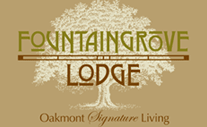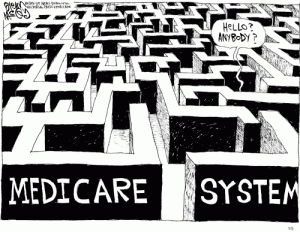When I sat down to write this article ended up writing two opening paragraphs. I honestly couldn’t figure out which one to use, so you get both.
Paragraph One
In the olden days . . . . there were hospitals, skilled nursing facilities, board and care homes, assisted living facilities and independent living, senior housing apartments. While competitive, the process of finding your place as a provider of senior housing, in the senior housing ecosystem was pretty easy. Where to look for new residents was pretty well defined. Today, our healthcare delivery system is rapidly changing those changes will impact all levels of senior housing. While the major driver for this change is cost, there is also a parallel desire to use a more holistic approach to caring for seniors. This changing environment is already creating new marketing challenges and new marketing opportunities.
Paragraph Two
A few months ago I was at a senior housing trade show breakout session that focused on the new healthcare paradigm and how assisted living fits into that paradigm. During the course of the discussion, someone in the audience raised their hand to ask how PACE programs fit into the mix. Not a single one of the “Experts” on the panel had any idea what the PACE program was, how it worked, or what impact the PACE program has on assisted living. At least one of those experts should have at the very least know what the PACE program is.
New Healthcare Paradigm Series
Even if you are running at 100% occupancy with a waiting list, you need to be paying attention to the changes taking place in the healthcare delivery system. If your building is full, these changes will have at least some impact on your community. If your community is not full, these changes will either make your occupancy headache worse or solve it.
This is a good news / bad news deal. . .If you operate a skilled nursing community, for perhaps the first time ever, you have the ability to make your services indispensable to your local hospital, by actively helping them to reduce 30 day readmissions. If you operate an assisted living community you have, for the first time, the opportunity to tap into both federal and state dollars. The bad news is that taking advantage of this shifting paradigm will take a lot of work. Not only that, it will feel confusing and messy. There will be lots of chasing rabbits down holes, only to find the rabbit has already moved on. This is mostly because the marketplace is extremely fluid and everyone is still trying to figure it out. There are fewer dollars to care for more seniors, who are living longer and expecting high levels of care. The regulations are getting more complex. No one really knows how it is all going to shake out. The opportunities and challenges will vary greatly from state to state and even from marketplace to marketplace. This series will provide you enough information to give you a starting point to figure out if you want to play. This series will likely run to 10 or so articles and there will be other articles interspersed with the series. The articles will all live under the tag “The New Healthcare Paradigm” to make them easy to find. I welcome any feedback you have along the way or suggestions on topics you would like to see addressed.
The next post will paint a theoretical picture of how an Assisted Living Community might take advantage of these changes. Steve Moran
Don’t miss a single issue of Senior Housing Forum, subscribe today. It is free! We do not sell or share your contact information. The posts are practical and never too long. Go to the main page of Senior Housing Forum and on the top you will see a place to enter your email to subscribe. You will receive notification when a new article is posted. You can unsubscribe at any time.
Finally: If you know anyone who is looking at emergency call systems I would appreciate the opportunity to talk with them about Vigil Health Solutions.









Steve,
I appreciate that you are shedding some light on this subject. I would encourage your readership to become proficient students in “Transitional Care.” It has been around for a long time, more specifically in the world of Peds and Disabled.
http://www.transitionalcare.info/
Dr. B
I agree that changes need to be made in this industry. And to focus on helping health care facilities reduce their costs is great, a better approach to this is to develope a program that keeps residents healthy, happy and engaged so they continue to live with grace purpose and joy. The communities who do this and have the data to show this will be the most successful for the new age seniors.
From LinkedIn Groups
Group: Assisted Living Professional Network
Discussion:The changing healthcare ecosystem is already impacting some segments of senior housing and will soon impact everyone.
Steve what an interesting article of which I enjoyed reading. I am feeling this “messy” reaction as you describe trying to find my way and the rabbits seem to all be gone. In this Healthcare Paradigm do you think home health companies fit in?
Posted by Kim Ivey
From LinkedIn Groups
Group: Senior Living & Care Professionals
Discussion:The changing healthcare ecosystem is already impacting some segments of senior housing and will soon impact everyone.
You bring a good point. Our children go to gym and drink more water than generations before. They start watching what they eat, and if guided by parents, make better food choices. The ‘healthier trend’ already shows in some upscale living communities. The trend will continue. Looking forward your next articles.
Posted by Margaret Szalata
Kim, you ask a good question. Home Health is sort of outside my area of interest and expertise. That being said, One of the realities senior housing providers need to face is that most people would prefer to not go into a senior housing community and as such, Home Health be continue to be a key player. I suspect payors will take a harder look at outcome data and that good agencies will flurish and it will be harder for not so good agencies.
Steve Moran
Great discussion. As providers, we have to keep abreast of the changes on the demand side or we will find ourselves sitting alone in a large building!
The PACE model is the most cost effective treatment model there is. It is an all inclusive model with its aim to keep people in the community. With better, knowledge of a persons medical needs over time, it is possible to reduce the costs of the acute hospital experience dramatically, and virtually eliminate long term care by providing wrap around services in the home in conjunction with wellness services. The transitional nurse is a critical factor in all of these areas and I appreciate the link to the transitional nurse course work. All “buildings” whether they are acute, subacute, skilled nursing or assisted living need to take a look at their transitions and contemplate wrap around services post discharge to stay viable in the future.
Great topic, great comments. Here is some information you might find interesting. IN the last month there have been two articles in the Dallas Morning News talking about how hospitals are ramping up their acquisitions of physician practices, while also partnering with home health agencies. As mentioned, the driving force being all of this is the reduction in hospital readmissions and the ultimate costs that come with it.
Hospitals need primary care physicians and transitional nurses (as Yvonne pointed out) to establish post-acute ACO’s (accountable care organizations). Hospitals are out to make partnerships with those senior housing organizations that understand their goals, reduce readmissions.
And while the assisted living industry has had the luxury of being the ‘social model’, times are now changing. This even applies to independent living as well, both recognizing the goal is that their residents need ‘clinical oversight’ to simply keep readmissions down. Both independent and assisted living should recognize the need to partner with hospitals, physicians, even home health as our society blends the social model with the medical model.
Home health agencies that understand these changes stand to gain significantly as well as their nurses can work with hospitals to become the transitional nurse, monitor patients, provide physical/occupational therapy and keep them out of the emergency room.
From LinkedIn Groups
Glenn Klingensmith •
Steve, What do you foresee for an independent community?
From LinkedIn Groups
Kim Ivey • Glenn I think that independent living will increase in the next two decades. The number of older Americans will increase to the point that by the year 2030 one out of every five Americans will be 65 or older.
From LinkedIn Groups
Glenn, I kind of agree with Kim, in that as people age and need slightly more assistance and community independent living will be a way to downsize and therefore save money. I also think that independent living communities will become more proactive in helping residents who need some help find resources to provide that help and therefore allow them to stay in those independent living apartments longer.
Steve Moran
If assisted living providers want to join the new healthcare paradigm, they need to be collecting the types of data that the acute care systems value in deciding who are worthy partners in their reach for the triple aim. More than ever before, older adult service providers are in a position of strength if they are creating clinical models that prevent the need for acute care, and, models that link them to the acute care system (transitional nurses, etc.) – these practices and more, combined with solid data management, move older adult service providers into the game where they may finally become serious players.
The roots of assisted residing may well be traced back again to the 1990’s when this sort of communities arrived into existence and went outside of
offering mere unbiased residing or eldercare.
For example, if the earnings restrict is $750 per thirty day period and your profits is $850,
you may possibly be able to spend $100 on healthcare fees
and Medicaid may underwrite your medical coverage for the rest of the month.
They could need excess guidance although getting old at dwelling, especially if they are acquiring problems living
on their have.